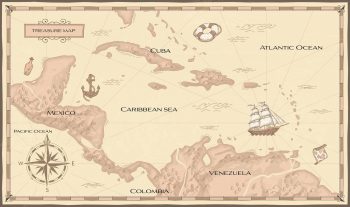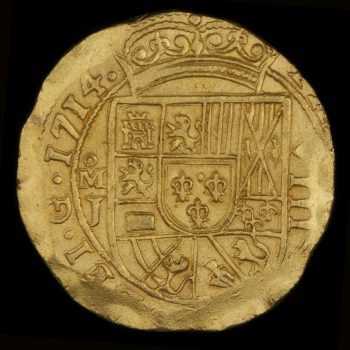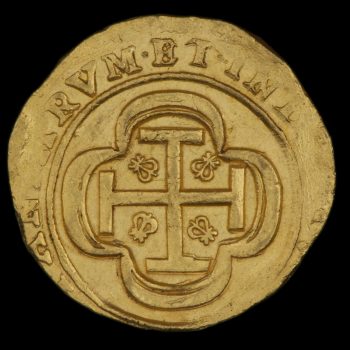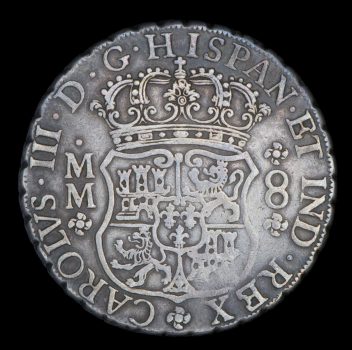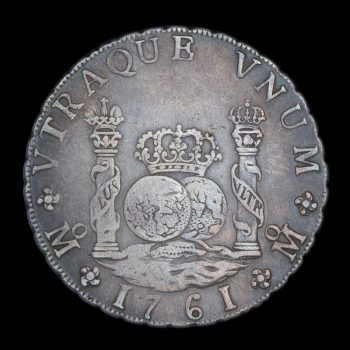
Have fun making pirate coins based on historical examples from our collection and create your very own treasure chest.
Description
Pirates have a long and varied history. You can find pirates at different times in history nearly everywhere in the world, sailing the seven seas on the hunt for ships carrying riches. There were even pirates in Canada, in the Gulf of St. Lawrence! This activity will teach you a bit more about the history of pirates and their plunder and show you how to make pirate coins and have your very own treasure hunt.
Ages
Five and up
Learning objectives
Students will:
- discover coins from history in the National Currency Collection
- make their own pirate currency based on historical examples
- create a treasure chest so they can have their very own treasure hunt
Materials
Pirate currency
- Air-dry modelling clay (or oven-bake clay, depending what you have on hand)
- Gold and silver water-based washable paint (e.g., gouache, acrylic paint, watercolours)
- Brushes and small rinsing jars
- Optional: sculpting tool to engrave details onto the coins
Treasure chest
- Treasure chest template printed on card stock, or a box for you to transform (like a tissue box)
- Scissors, glue and pencil crayons
- Decorations you have on hand (stickers, diamonds, shells, etc.)
Steps
1. Prepare the template (optional)
If you want to print the treasure chest template, follow these steps. Otherwise, find a box.
- Download the template.
- Print the template on card stock.
2. Set up the activity
- Consider keeping your computer on or printing out pictures of antique coins. You can use them as a visual guide while decorating your coins.
- Gather together all the materials you need to make the coins and leave a space where the coins can dry undisturbed.
- Prepare the materials to make your treasure chest.
3. Start the conversation
About 300 years ago, the Caribbean was full of pirates, who would attack the many ships carrying gold and silver treasure from Central and South America to Europe. Thousands of ships fell victim to Caribbean pirates!
Ships of this era carried treasure that included the Spanish silver eight real coin and the gold eight escudo coin. These two coins are the ones most commonly found in the legends and stories about pirate treasure.
The eight escudo coin, also called a gold doubloon, was a crudely minted gold coin from Latin America bound for Spain. At the time, metal coins in the Americas were cut so that their weight equalled their value in gold or silver, and they were minted with an image imprinted on them. All of this was done quickly, giving the coins the appearance of having been cut poorly.
The eight real coin, also called a “piece of eight”, was a heavy silver coin that could be divided into eight pieces. Can you imagine cutting up a coin to make change? People would refer to a quarter of a coin as “two bits.” Eight real coins were plentiful and used nearly everywhere, even in Canada, as they were known to be made of high quality metal.
Below, you can see pictures of some of the coins in our museum collection. Take a look.
- What image do you see on the coin?
- Do you recognize any of the drawings and symbols on the coins?
- What do they make you think of?
Look closely at the reverse image below. You can see two pillars, each wrapped in a banner. Some people think this is where the dollar sign ($) comes from.
4. Make your pirate currency
Now it’s your turn to create your own pieces of eight and gold doubloons, the famous pirate coins. If you pay attention to the details, your coins will look more real.
- Cut the modelling clay into small 2 cm cubes.
- Roll each cube in your hands until it forms a ball, then flatten with the palm of your hand to make a disc.
- With your brush handle (or sculpting tools), draw detailed engravings on the coins. Look at the pictures of the 8 real and 32 real coins to try and replicate them. You could even try drawing the banner wrapped pillars.
- Let the coins dry for as long as indicated on the clay packaging.
- Once the coins are dry, paint your gold doubloons gold and your pieces of eight silver. Let the paint dry.
5. Make your treasure chest
- If you decided to print the treasure chest template on the card stock, follow those instructions. The template will indicate where to cut and fold the paper. If you are not using the template, start decorating your box.
- Get creative! Paint your chest, draw some patterns on it and glue whatever decorations you like: shells, diamonds, ribbons, tassels, anything goes!
6. Have a treasure hunt
Time to play pirates! Have a treasure hunt outside. You can hide all of your bounty together in the chest or hide each coin separately for a longer treasure hunt. You can also make a treasure map or a series of riddles.
Consider having a whole pirate-themed day: watch a pirate movie, make some hardtack (biscuits that lasted a very long time at sea) and make your own pirate costumes.
Happy adventuring!
Bonus activities
Want to learn more about pirates? Here are a few different topics you could research:
- Did you know? There were also women pirates, like Mary Read, Anne Bonny and Ching Shih. In the 1800s, the notorious Ching Shih commanded her large fleet of pirate ships with an iron fist, scouring the South China Sea. Her exploits made her one of the wealthiest pirates of all time. She’s also known for the code of honour that she ordered the pirates under her command to follow.
- Have you heard of the famous pirate Blackbeard (Edward Teach)? He had a reputation for putting lit fuses in his huge beard to make him seem scarier, like he’d emerged from the depths of hell itself! How did he do this without burning his beard? No clue. It may just be a myth, but he did try very hard to gain a terrible reputation. He wanted to scare sailors so he could steal their precious cargo without a fight.
- There were also pirates in Canada. Eric Cobham and Maria Lindsey were a pirate couple based out of Newfoundland who attacked ships coming through the Gulf of St. Lawrence. They were said to leave no survivors.
We want to hear from you
Comment or suggestion? Fill out this form.
Questions? Send us an email.
